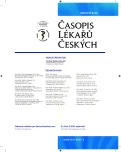Pharmaconutrition in intensive and perioperative care
Authors:
Zdeněk Zadák; Radomír Hyšpler; Alena Tichá
Authors‘ workplace:
Centrum pro výzkum a vývoj, Fakultní nemocnice, Hradec Králové
Published in:
Čas. Lék. čes. 2015; 154: 212-215
Category:
Review Articles
Overview
The review article covers specific methods of artificial nutrition in current advances in intensive care. This area of care is somewhat specific, and indications for pharmaconutrients are different from classical artificial nutrition. The pharmaconutrients of amino acid and polyenoic fatty acid groups are described. The components of nutritional pharmacology, based on exceedingly high doses of pure nutritional substrates, are a useful and safe means of modifying selected mechanisms, such as fluidocoagulation, inflammatory reactions or vasomotorics.
Keywords:
pharmaconutrition – inflammatory mediators – polyunsaturated fatty acids – citruline – arginine – bowel barrier
Sources
1. Furst P, Kuhn KS. Amino-acids substrates in new bottles: implications for clinical nutrition in the 21st century. Nutrition 2000; 16 : 603–606.
2. Hardy G, Manzanares W. Pharmaconutrition: How has this concept evolved in the last two decades? Nutrition 2011; 27 : 1090–1092.
3. Hardy G. Nutraceuticals and functional fous. Nutrition 2000; 16 : 688–689.
4. Newsholme EA, Hardy G. Supplementation of diets with nutritional pharmaceuticals. Nutrition 1997; 13 : 837–839.
5. Pontes-Arruda A, Demichele S, Seth A., Singer P. The use of an inflammation-modulating diet in patients with acute lung injury or acute respiratory distress syndrome: a meta-analysis of outcome data. JPEN 2008; 32 : 596–605.
6. Zadák Z. Výživa v intenzivní péči. 2. přepracované vydání. Praha: Grada Publishing 2008.
7. Calder PC. The 2008 ESPEN Sir David Cuthbertson lecture: Fatty acids and inflammation – From the membrane to the nucleus and from the laboratory bench to the clinic. Clinical Nutrition 2010; 29 : 5–12.
8. Pontes-Arruda A, Aragao AM, Albuquerque JD. Effects of enteral feeding with eicosapentaenoic acid, gamma-linolenic acid, and antioxidants in mechanically ventilated patients with severe sepsis and septic shock. Critical Care Medicine 2006; 34 : 2325–2333.
9. Singer P, Theilla M, Fisher H, Gibstein I, Grozovski E, Cohen J. Benefit of an enteral diet enriched with eicosapentaenoic acid and gamma-linolenic acid in ventilated patients with acute lung injury. Critical Care Medicine 2006; 34 : 1033–1038.
10. Tsekos E, Reuter C, Stehle P, Boden G. Perioperative administrativ of parenteral fish oil supplements in a routine clinical setting improves patient outcome after major abdominal Sumery. Clinical Nutrition 2004; 23 : 325–330.
11. Weiss G, Meyer F, Matthies B, Pross M, Koenig W, Lippert H. Immunomodulation by perioperative administrativ of n-3 fatty acids. Br J Nutr 2002; 87: S103–S110.
12. Alexander JW. Nutritional pharmacology in surgical patients. The American Journal of Surgery 2002; 183 : 349–352.
13. Efron D, Barbul A. Role of arginine in immunonutrition. Journal of Gastroenterology 2000; 35(Suppl XII): 20–23.
14. Evoy D, Lieberman MD, Fahey TJ. III, et al. Immunonutrition: The role of arginine. Nutrition 1998; 14 : 611–617.
15. Rosenthal MD, et al. Evolving paradigma in the nutritional support of critically ill surgical patients. Current Problems in Surgery 2015; 52 : 147–182.
Labels
Addictology Allergology and clinical immunology Angiology Audiology Clinical biochemistry Dermatology & STDs Paediatric gastroenterology Paediatric surgery Paediatric cardiology Paediatric neurology Paediatric ENT Paediatric psychiatry Paediatric rheumatology Diabetology Pharmacy Vascular surgery Pain management Dental HygienistArticle was published in
Journal of Czech Physicians

Most read in this issue
- New psychoactive substances and their prevalence in the Czech Republic
- Ultrasound elastography and its use in the head and neck imaging
- The Cryopre-servation: history and the ethical issue of storing embryos
- Pharmaconutrition in intensive and perioperative care
